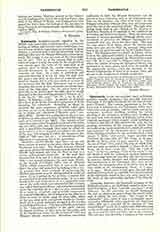

Tabernacle (TABERNACULUM) signified in the Middle Ages sometimes a ciborium-altar, a structure resting on pillars and covered with a baldachino that was set over an altar, sometimes an ostensory or monstrance, a tower-shaped vessel for preserving and exhibiting relics and the Blessed Sacrament, sometimes, lastly, like today, it was the name of the vessel holding the pyx. That is, at the present time in ecclesiastical usage it is only the name for the receptacle or case placed upon the table of the high altar or of another altar in which the vessels containing the Blessed Sacrament, as the ciborium, monstrance custodia, are kept. As a rule, in cathedrals and monastic churches it is not set upon the high altar but upon a side altar, or the altar of a special sacramentary chapel; this is to be done both on account of the reverence due the Holy Sacrament and to avoid impeding the course of the ceremonies in solemn functions at the high altar. On the other hand it is generally to be placed upon the high altar in parish churches as the most befitting position (“Caerem. ep.”, I, xii, No. 8; “Rit. rom.”, tit. IV, i, no. 6; S. C. Episc., February 10, 1579). A number of decisions have been given by the Sacred Congregation of Rites regarding the tabernacle. According to these, to mention the more important decisions, relics and pictures are not to be displayed for veneration either on or before the tabernacle (“Decreta auth.”, nos. 2613, 2906). Neither is it permissible to place a vase of flowers in such manner before the door of the tabernacle as to conceal it (no. 2067). The interior of the tabernacle must either be gilded or covered with white silk (no. 4035, ad 4); but the exterior is to be equipped with a mantle-like hanging, that must be either always white or is to be changed according to the color of the day; this hanging is called the canopeum (no. 3520; cf. “Rit. rom., loc. cit.). A benediction of the tabernacle is customary but is not prescribed.
HISTORY.—In the Middle Ages there was no uniform custom in regard to the place where the Blessed Sacrament was kept. The Fourth Lateran Council and many provincial and diocesan synods held in the Middle Ages require only that the Host be kept in a secure, well-fastened receptacle. At the most they demand that it be put in a clean, conspicuous place. Only a few synods designate the spot more closely, as the Synods of Cologne (1281) and of Munster (1279), which commanded that it was to be kept above the altar and protected by locking with a key. In general, four main methods of preserving the Blessed Sacrament may be distinguished in medieval times: (I) in a cabinet in the sacristy, a custom that is connected with early Christian usage; (2) in a cupboard in the wall of the choir or in a projection from one of the walls which was constructed like a tower, was called Sacrament-House, and sometimes reached up to the vaulting; (3) in a dove or pyx, surrounded by a cover or receptacle and generally surmounted by a small baldachino, which hung over the altar by a chain or cord; (4) lastly, upon the altar table, either in the pyx alone or in a receptacle similar to a tabernacle, or in a small cupboard arranged in the reredos or predella of the altar. This last method is mentioned in the “Admonitio synodalis” of the ninth century by Regino of Prum (d. 915), later by Durandus, and in the regulations issued by the Synods of Trier and Munster already mentioned. Reredoses containing cupboards to hold the Blessed Sacrament can be proved to have existed as early as the fourteenth century, as, for instance, the altar of St. Clara in the Cologne cathedral, although they were not numerous until the end of the medieval period. The high altar dating from 1424 in the Church of St. Martin at Landshut, Bavaria, is an example of the combination of reredos and Sacrament-House. From the sixteenth century it became gradually, although slowly, more customary to preserve the Blessed Sacrament in a receptacle that rose above the altar table. This was the case above all at Rome, where the custom first came into use; and in Italy in general, influenced largely by the good example set by St. Charles Borromeo. The change came very slowly in France, where even in the eighteenth century it was still customary in many cathedrals to suspend the Blessed Sacrament over the altar, and also in Belgium and Germany, where the custom of using the Sacrament-House was maintained in many places until after the middle of the nineteenth century, when the decision of the Sacred Congregation of Rites of August 21, 1863, put an end to the employment of such receptacles.
JOSEPH BRAUN

